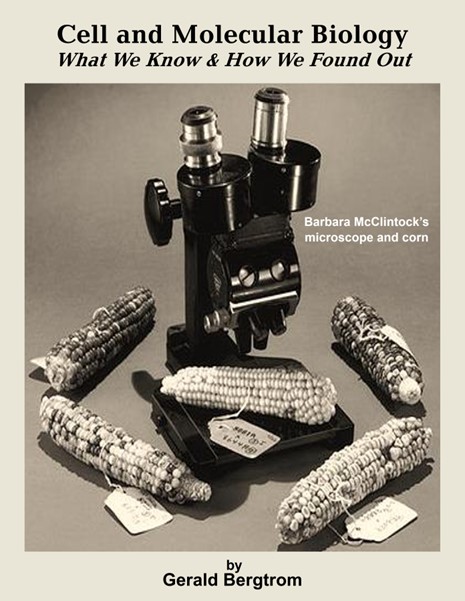NOTE:
You have been redirected to the 5th edition of Cell and Molecular Biology 5e: What We Know & How We Found Out (CMB5e). CMB5e is updated (as of 2020) and enhanced from previous editions, with new content and no loss of original content. All of the earlier editions and versions of CMB will still be available if necessary, by request directly from the author (bergtrom@uwm.edu). However, we hope that you will like the improvements and that you will find CMB5e a useful upgrade and update. Of course, any and all comments that will help to improve the book for the next release are welcome.
CMB5e is the latest edition of an interactive Open Educational Resource (OER) electronic textbook (iText), available under a Creative Commons CC-BY license. Like earlier editions, CMB5e opens with a short history of the discipline and a discussion of scientific method. The book remains focused on the understanding of evolution that informs all of the life sciences and continues to provide experimental support for what we know about cell and molecular biology. Having a sense of how science is practiced and how investigators think about experimental results is essential to understanding the relationship of cell structure and function, not to mention the natural world around us. CMB5e is available in three versions (plus a sample chapter):
- In each chapter of the Basic CMB5e iText, an introduction includes learning objectives and context-embedded links to short explanatory voice-over PowerPoint recordings (VOPs) and other web-links of interest. QR codes allow the reader just-in-time access to the VOPs on smart phones or any camera-enabled portable device.
- The Annotated CMB5e adds pre-written, interactive context-embedded Challenge boxes to the Basic version of the book. These contain open-ended questions that expand on text readings. Any or all of them can be the basis of informal class and online discussion or as graded assignments.
- The Instructor’s CMB5e iText adds a series of 25 Words or Less essay questions that the author used as short (i.e., easy to grade!) writing assignments to strengthen student’s critical thinking and writing skills.
- A CMB5e Sample Chapter.
- The Art and Illustration Resource for Cell and Molecular Biology contains high resolution JPGs of figures in all CMB5 digital and print versions. JPGs are all public domain or CC-BY licensed (a source list is included).
Freely download the sample chapter by clicking on the CMB5e Sample Chapter link below. To download the Basic or Annotated iText, choose and click the desired link below. A short form will appear. Please provide a bit of (anonymous) information, submit the form, and then download your iText. iText users can enter their own digital annotations or print text pages and write in the margins. For students preferring to study from a printed book, a low-cost print version of the Annotated CMB5e (covered by a Creative Commons CC-BY-NC-SA license) is an option.
If you are an instructor, click the Instructors CMB5e iText link below to fill out and submit the short form that appears. Instructors will receive both PDF and MS-Word files of all versions of the digital iText. Use the book ‘as is’ or as the starting point to build their own custom iText. After adding or deleting content, annotations, assignments, etc., the customized iText can then be the required (or recommended) course content, to be distributed to students under the guidelines of the Creative Commons CCBY license. Instructors also receive the Art and Illustration Resource for Cell and Molecular Biology. Use the image files to supplement e.g., PowerPoint presentations used in online or face-to-face learning.
I encourage instructors with an interest in interactive learning and a concern about the high cost of textbooks to customize one of the CMB5e versions to engage their own students in thinking about science. You can even ask students to try their hand at writing their own Challenge Box or essay questions, perhaps reflecting what they are wondering about!
If you are a student, check out the links in whichever version you are reading to think about how good experiments were designed, how data was interpreted, and what questions the investigators (and we!) might want to ask next. If you are using the Annotated or Instructor’s CMB5e, I encourage you to accept the challenges in some of the Challenge boxes (even if they are not assigned by your instructor)…, and to wonder about cell and molecular biology and how it all works! Here are links to the CMB5e versions and resources:
- Annotated CMB5e iText: Full text with VOPs and web-links, plus annotations
- Basic CMB5e iText: Full text with VOPs and web-links
- Instructor’s CMB5e iText: Full text with VOPS, web-links and annotations, plus the author's assignments/assessments.
- Sample Chapter CMB5e iText
- Art and Illustration Resource for Cell and Molecular Biology
-

Art and Illustration Resource for Cell and Molecular Biology: What We Know & How We Found Out
Gerald Bergtrom
This Art & Illustration Resource contains the figures (photographs, illustrations etc.) in the 5th edition Cell and Molecular Biology; What We Know AND How We Found Out (all versions). The images are high-resolution JPG files, sufficient for projection in large size classrooms, and thus useful for creating or supplementing PowerPoint or similar presentations to support classroom, online teaching and learning, and/or to support in-class or homework assignments. Just download and extract the zipped folder to access the chapter-by-chapter numbered figure files. The images are also Open Access (either public domain, CC-licensed, or equivalent). The Chapter-by-Chapter folders come with a PDF file including a complete list of image sources.




